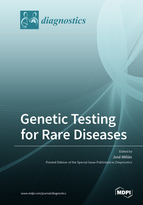Genetic Testing for Rare Diseases
A special issue of Diagnostics (ISSN 2075-4418). This special issue belongs to the section "Pathology and Molecular Diagnostics".
Deadline for manuscript submissions: closed (31 December 2021) | Viewed by 35917
Special Issue Editor
Special Issue Information
Dear Colleagues,
Rare diseases are defined by their low prevalence but, as a whole, they affect 8–10% of the population in Western countries. Six to seven thousand rare diseases have been reported in the literature, and the number is regularly increasing. There are many differences among them in terms of etiopathology, age of onset, affected organs and tissues, etc., but about 80% of them have a genetic cause.
Therefore, the genetic testing of rare diseases is a key point for confirming the clinical diagnosis, offering the correct genetic counseling to the patients and their relatives and, more recently, the possibility of receiving a treatment or engaging in a DNA-based clinical trial.
High-throughput sequencing has revolutionized the field of genetic testing. The previous screening methods based on gene-by-gene strategies have now been replaced by custom panels, clinical exomes, or even whole-exome sequencing. However, the best strategy for each disease or group of diseases depends on the genetic nature of that disease, the number of involved genes, or the type of mutation.
This Special Issue will be focused on clinical genetics, genetic counselling, rare metabolic diseases, sensorineural disorders, neuromuscular diseases, and bioinformatics, among other topics.
Dr. José Millán
Guest Editor
Manuscript Submission Information
Manuscripts should be submitted online at www.mdpi.com by registering and logging in to this website. Once you are registered, click here to go to the submission form. Manuscripts can be submitted until the deadline. All submissions that pass pre-check are peer-reviewed. Accepted papers will be published continuously in the journal (as soon as accepted) and will be listed together on the special issue website. Research articles, review articles as well as short communications are invited. For planned papers, a title and short abstract (about 100 words) can be sent to the Editorial Office for announcement on this website.
Submitted manuscripts should not have been published previously, nor be under consideration for publication elsewhere (except conference proceedings papers). All manuscripts are thoroughly refereed through a single-blind peer-review process. A guide for authors and other relevant information for submission of manuscripts is available on the Instructions for Authors page. Diagnostics is an international peer-reviewed open access semimonthly journal published by MDPI.
Please visit the Instructions for Authors page before submitting a manuscript. The Article Processing Charge (APC) for publication in this open access journal is 2600 CHF (Swiss Francs). Submitted papers should be well formatted and use good English. Authors may use MDPI's English editing service prior to publication or during author revisions.
Keywords
- clinical genetics
- bioinformatics
- genetic counselling
- sensorineural disorders
- neurodevelopment
- metabolic diseases
- neurological diseases
- rare pediatric diseases







